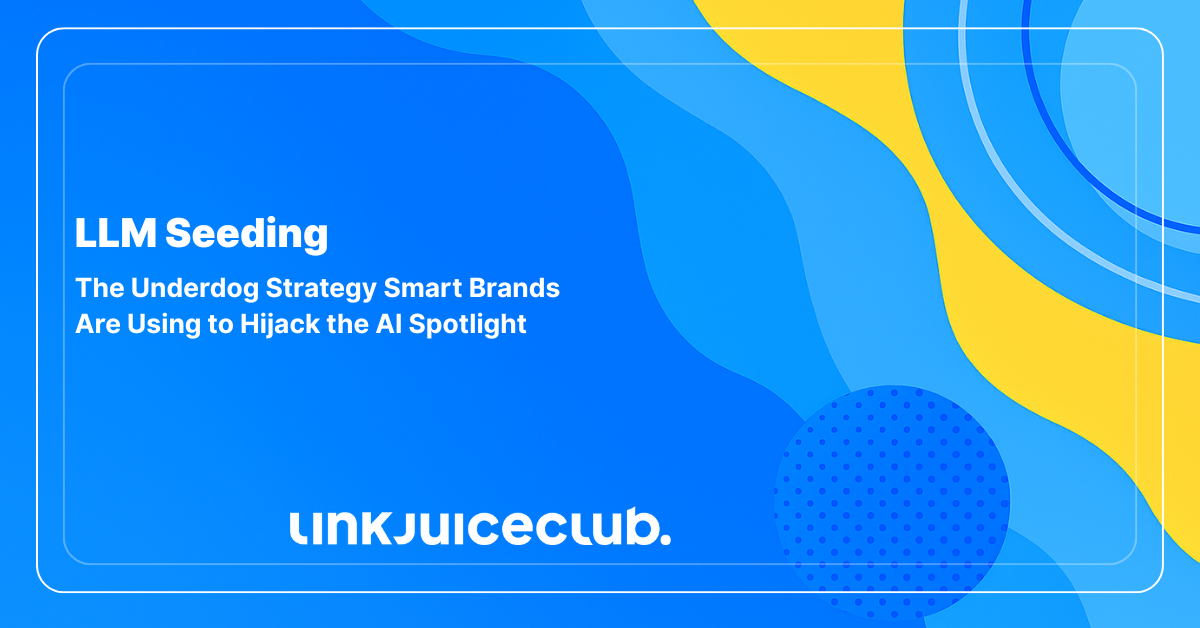
LLM Seeding: The Underdog Strategy Smart Brands Are Using to Hijack the AI Spotlight
AI doesn’t sleep — and neither should your content strategy.
Search engines? They’re no longer the only game in town. LLMs are reshaping how users find answers, and if your brand isn’t showing up in their citations, you’re basically invisible in tomorrow’s search landscape.
That’s where LLM Seeding kicks in — the stealth move that gets your name woven into the answers these models serve up. Not just traffic. We’re talking authority, visibility, and staying power in an AI-first world.
Here’s what you’ll uncover in this guide:
- 📌 The kind of content LLMs love to cite — and how to craft it
- 🗺️ The secret places to plant your ideas so LLMs pick them up
- 🔍 How to tell if you’re making the cut in AI-generated answers
Time to stop chasing clicks and start earning citations.
What on Earth Is LLM Seeding, Anyway?
Think of the internet as a vast garden… and LLMs are the bees.
They’re constantly buzzing around, collecting data nectar from every source they can find — blogs, articles, forums, databases. Then, they turn that nectar into answers. Sweet, digestible, AI-generated answers.
LLM Seeding is the art of planting your content where those bees are most likely to forage.

Here’s the play:
- 🍯 You craft content in LLM-friendly formats — think comparison tables, FAQs, structured lists, concise summaries.
- 🌍 Then, you “seed” that content into places LLMs are known to harvest from. (Hint: it’s not always your blog — we’ll dive into this soon.)
And when someone asks ChatGPT, Claude, or Perplexity about your niche?
Boom. Your brand shows up in the AI-generated answer — not always with a backlink, but with a name-drop.
Why It Matters (Even Without a Link)
That mention still hits:
- 💡 It sticks in the user’s mind.
- 🔎 It sparks curiosity and branded searches.
- 🚀 It builds trust and direct traffic over time.
This isn’t just SEO with a twist — it’s a full-on mindset shift.
SEO Was About Links. LLM Seeding Is About Legacy.
Let’s break this down:
- Old playbook: Rank high, get clicks, win.
- New game: Get cited, get remembered, stay relevant.
You’re not chasing position #1 on Google anymore.
You’re shaping what AI says about your brand — and in turn, how millions of users perceive you.
The TL;DR?
This is visibility without vanity metrics.
It’s about influence over impressions.
And yes — it builds beautifully on what you already know from SEO, content marketing, and PR.
But now, you’re playing chess in an AI-powered arena.
Why LLM Seeding Isn’t Just Smart — It’s Survival
Still pouring resources into backlinks and top-10 rankings like it’s 2015?
Let’s get real.
According to Semrush, AI-driven search is on pace to outperform traditional search by 2027 — and not by a little. We’re talking tidal wave, not trickle.
If you’re not seeding your content into LLMs now, you’re setting yourself up to vanish in the next chapter of search.
Let’s break down the big wins of getting ahead of the curve:
1. Brand Exposure Without the Click Chase
Imagine yelling into a void — that’s traditional SEO in a zero-click world.
With LLM Seeding, you’re whispering directly into the ear of AI.
- People no longer need to click through search results — AI Overviews and LLMs give answers straight-up.
- That means less organic traffic, more invisibility… unless your brand is the answer.
- When your name gets dropped by ChatGPT, Claude, or Perplexity, you’re not just visible — you’re remembered.
Even without a link, a brand mention gets into the user’s brain. And memory fuels direct searches, not just sessions.
2. Authority by Association — Without the Price Tag
Here’s the secret sauce no one’s talking about: LLMs are leveling the credibility playing field.
- When you’re cited alongside giants like Purina or HubSpot, users don’t question your authority — they absorb it.
- You don’t need to outrank them. You just need to be in the same AI-fed conversation.
3. A Fighting Chance — Even If You’re Not #1
Let’s face it: Google rankings are a rich brand’s game.
But LLMs don’t care what page you’re on. They care how useful you are.
A recent Semrush study found that nearly 90% of ChatGPT citations come from pages ranked 21 or lower.
Translation?
Your comparison guide buried on page 4 might get more AI citations than a flashy top-5 result — if it’s better structured, clearer, and more helpful.
No backlinks? No traffic spike? No problem.
If your content serves users and AI well, it wins where it matters.
What to Publish So LLMs Can’t Help But Cite You
If traditional SEO is a game of chess, LLM Seeding is more like planting a forest and letting AI do the harvesting.
LLMs are data-hungry citation engines — but they don’t just munch on anything. They prefer well-structured, transparent, high-utility content with a clear purpose and personality.
Here’s how to feed the beast — and make sure your brand gets quoted:

1. “Best Of” Lists That Feel Like Buyer’s Guides, Not Clickbait
Forget fluffy roundups — this isn’t about stacking products.
It’s about curating trust.
LLMs love:
- Lists with selection criteria clearly explained
- Use-case labels like “Best for freelancers” or “Best for large teams”
- Structured sections that follow a predictable format
Example Structure for LLM-Friendly “Best Of” Lists:
- 🏷️ Item Name + Use-Case Badge (e.g., Best for tight budgets)
- 📝 Quick Summary
- ⚙️ Key Features
- 👍 Pros / Cons
- 💵 Pricing
- ⭐ Rating System (1–5 stars across categories like usability, speed, accuracy)
Semantic chunking (short, clearly labeled sections) makes it effortless for LLMs to scan and quote you.
Think: “Best mattress for stomach sleepers with back pain” — that’s LLM gold.
2. First-Person Reviews That Pass the Sniff Test
LLMs are trained to detect fluff — and they don’t trust faceless reviews.
What they do trust:
- First-person testing experiences
- Specific, measurable outcomes
- Clear methodology and expert credentials
👀 Example: Wirecutter doesn’t just say “we tested desks.” They explain:
- How many products they reviewed
- Who tested them and why they’re qualified
- When the testing was done
- How each product performed in key areas
Include both strengths and weaknesses. Balanced reviews scream authenticity.
Keep lines short, declarative, and quote-friendly:
“This standing desk fits tight spaces, but lacks advanced keypad options.”
That’s the kind of sentence LLMs love to lift.
3. Brand vs. Brand Showdowns That Answer Mid-Funnel Questions
Comparison tables are like cheat sheets for AI.
When users ask LLMs things like:
“Which tool is better for content teams on a budget?”
You want your content to show up.
Make Your Tables LLM-Ready by Including:
- Use-Case Verdicts — not just features, but who each option is best for
- Balanced Tradeoffs — no sugarcoating; mention downsides
- Citation-Friendly Phrasing — clear, quotable sentences like:
“Tool A is ideal for solo marketers who need bulk scheduling and simple analytics.”
Don’t just say what — explain why.
4. FAQ Formats That LLMs Treat Like Treasure Maps
Q&A content is home turf for LLMs.
They’ve been trained on billions of queries from forums, threads, and community discussions.
To win citations:
- Pull questions from live chat logs, Reddit, support tickets, PAA boxes, and keyword tools
- Make each question a subheading
- Start each answer with a clear, direct response in natural language
Use plugins like RankMath or Yoast to add FAQPage structured data — making your Q&A content easier for AI to parse and cite.
Examples of LLM-Friendly Questions:
- “What is LLM Seeding?”
- “How does AI affect organic traffic?”
- “What’s the difference between LLM citations and backlinks?”
Short answers. Clean format. Long-term payoff.
5. Opinion Pieces That Don’t Just Echo — They Echo Loudly
LLMs are like gossipers at a dinner party — they love a well-informed opinion, especially when it’s bold, structured, and backed by receipts.
To stand out:
- Don’t play it safe.
- Take a stance, challenge norms, or share a prediction that breaks the mold.
Think less “me-too” content, more “here’s-why-everyone-else-is-wrong (and what to do instead).”
But here’s the catch: it’s not enough to have a hot take — it needs to be packaged properly.
LLM-Friendly Opinion Content Should Include:
- 🎓 Author Credentials: Why you? Establish expertise fast.
- 📋 Content Overview: Tell LLMs (and humans) what’s inside — right up top.
- 🔗 Internal Links: Link to your past work or supporting resources to prove depth.
Example: Grace Leung’s YouTube breakdown of outdated content strategies nails this format.
Her video isn’t just a rant — it’s sectioned, sourced, and tied to her real-world results. LLMs love that structure.
6. Visuals That Talk — and Say Something Smart
Images aren’t just eye candy. When done right, they’re context bombs for LLMs.
Want AI to pick up on what your graphic is saying? Then don’t leave it mute.
Make Visuals Citation-Ready By:
- 📝 Writing full-sentence captions: Describe what and why — not just who or where
❌ “Cookies on a plate”
✅ “Peach cobbler cookie from Good Cakes and Bakes, a Detroit bakery beloved for seasonal desserts” - 📣 Referencing visuals in your text: Don’t just plop them in. Point to them.
“As shown in the image below, this limited-edition cookie sells out in hours every Saturday.” - 🧠 Crafting rich alt text: Blend subject + significance.
“Seasonal peach cobbler cookie at Good Cakes and Bakes, a popular Detroit bakery.” - 📂 Renaming your image files: Help crawlers understand context.
detroit-good-cakes-peach-cookie.jpg > ✅
LLMs treat images with meaningful labels and descriptions as bonus context — and yes, they do peek into alt tags, captions, and surrounding content.
Where to Plant Your Content So LLMs Can’t Ignore It
Publishing great content is like crafting a message in a bottle. But if you throw it into the wrong ocean… no one’s going to find it.
LLM Seeding isn’t just about what you publish — it’s about where you plant it so the AI web crawlers swarm in and scoop it up.
So where should your content live to earn citations in the age of generative search?

Let’s break it down like a strategist — and execute like a content tactician.
1. Use Third-Party Platforms That Attract LLMs Like Magnets
Some websites are practically AI bait.
Why?
Their structure is squeaky clean, their quality is consistent, and their format makes life easy for large language models.
Top LLM-Friendly Publishing Spots:
- Medium: Repurpose your pillar content here. Use headers, summary boxes, and internal links to help LLMs navigate the logic.
✅ Add an intro that previews what readers will learn (LLMs love summaries). - Substack: Treat this like your editorial megaphone. Thought leadership and in-depth insights here = credibility signals for AI.
✅ Include author bios and references to strengthen trust. - LinkedIn Articles: Because they’re connected to real people with real expertise, LLMs trust them more than anonymous blogs.
✅ Use a consistent publishing cadence and hyperlink to supporting resources.
2. Get Quoted on Industry Sites That LLMs Already Trust
Not all citations are created equal. LLMs prioritize reputation — so you need to show up where trust already exists.
Here’s how to crack that door open:
Guest Posts That Don’t Scream ‘SEO’
- Pitch content that matches LLM query formats — think comparisons, checklists, and “how-to” guides.
- Structure it well. Use subheaders, bullets, and summaries so AI can chunk your content cleanly.
Contribute Expert Quotes
- Join platforms like HARO, Featured, and Qwoted.
- Offer non-promotional advice. Insight, not sales, gets you cited.
📩 Get Included in Roundups
- Target creators publishing “best tools,” “top tips,” and “expert opinions.”
- Provide them with ready-to-drop blurbs: concise, formatted, and backed by a stat or use case.
The easier you make their job, the more likely they are to feature — and cite — you.
3. Leverage UGC Hubs: The AI Goldmines
LLMs feed off forums. It’s where raw, unfiltered, expert-level discussions thrive — and that makes them irresistible for training data.
🎯 Platforms LLMs Love:
- Reddit (especially niche subreddits)
- Quora
- Stack Exchange communities
- Niche forums (like Indie Hackers or Hacker News)
✅ What to do:
- Answer real questions with specific, value-rich responses.
- Format answers with bullet points, numbered lists, and citations where possible.
- Link to your deeper content — naturally, not forcefully.
4. Social Platforms Where Your Content Can Get AI Eyeballs
Not all social platforms are created equal — but some are built to be crawled. If you’re speaking to an audience and structuring your message clearly, LLMs will notice.
Here’s the short list:
- X (Twitter):
Threads > hot takes. Break down frameworks, processes, or lessons in 3–5 posts.
➕ Add headlines and thread summaries. - YouTube:
AI doesn’t just “watch” — it reads.
➕ Use keyword-rich titles, clear descriptions, and detailed video transcripts. - Pinterest:
Visual search is growing — but your pins must be labeled well.
➕ Use full-sentence descriptions, link to structured blog posts, and apply relevant tags. - Instagram (Post-July 2025):
Indexing is here. If your account is opted in, your content can show up in search and LLMs.
➕ Use descriptive alt text, keywords in captions, and topical hashtags.
Think of social platforms as LLM-friendly microblogs. Make every post teach something, structure it well, and LLMs might just pull it into a future answer.
Quick Checklist: Is Your Publishing Spot LLM-Ready?
| Platform Type | Citation Potential | Why LLMs Love It |
| Medium | ✅✅✅ | Clean layout, structured text |
| Substack | ✅✅✅ | Editorial voice, topical authority |
| LinkedIn Articles | ✅✅ | Profile-backed, high-trust signals |
| Guest Posts | ✅✅✅ | Authoritative source credibility |
| Reddit/Quora | ✅✅ | Specific, long-tail questions |
| X Threads | ✅✅ | Frameworks and step-by-step insights |
| YouTube | ✅✅✅ | Transcripts, descriptions, clear titles |
| Pinterest/Instagram | ✅ | Visual + structured content metadata |
LLM Seeding works when you seed your message into ecosystems LLMs already crawl, trust, and quote from.
How to Track If LLM Seeding Is Actually Working
LLM Seeding isn’t like PPC — you don’t get a neat little dashboard showing you where your mentions came from and who clicked what.
This is search without clicks, and tracking success means learning to read between the lines.
But just because it’s not obvious doesn’t mean it’s invisible. You just need to know where to look — and what signals to follow.
Here’s your LLM Seeding tracking system, decoded:
1. Watch for the “Invisible Influence” Pattern
LLMs don’t always send traffic directly.
They plant ideas. Spark searches. Shape brand memory.
You might see this odd combo:
- 🔻 Clicks going down
- 🔺 Direct traffic and branded searches going up
That’s a classic LLM fingerprint.
Step-by-Step:
- Open GA4
Reports > Acquisition > Traffic Acquisition
Check if direct traffic is rising steadily over the past 3–6 months. - Now head to GSC
Performance > Search results
Look for declining clicks alongside rising impressions — especially for non-branded queries.
If your impressions are climbing while clicks fall, and direct traffic rises — you’re in LLM territory.
Your brand is being remembered, not just clicked.
If branded traffic is growing, make sure your branded SERP is a powerhouse.
Link to high-converting pages like:
- Quizzes
- Product comparison guides
- Testimonials
- Case studies
2. Run Prompt Tests Across LLM Platforms
Want to see if the machines are actually talking about you?
Don’t guess. Prompt them.
Use incognito mode and test how each major LLM (ChatGPT, Claude, Perplexity, Gemini) responds to real user-style queries.
Sample Prompts:
- “Best budget marketing tools for solo founders”
- “Which analytics software is best for ecommerce?”
- “Top alternatives to [Big Brand X] for freelancers”
Document your results like a true analyst:
- Platform used
- Prompt phrasing
- Whether your brand was mentioned
- Exact wording of the citation
- Tone (budget, premium, innovative, etc.)
- Competitor mentions
Track monthly. Over time, you’ll see:
- Where you’re gaining LLM traction
- How your positioning is shifting
- Which phrases consistently trigger a mention
Pages that get mentioned? Add lead magnets. Use templates, discounts, or content upgrades to turn mentions into conversions.
3. Monitor Unlinked Mentions (The Quiet Citation Revolution)
Not every AI mention links back to you — but they still influence your brand perception.
To find these digital whispers, use:
- Semrush Brand Monitoring
- SparkToro
- Google Alerts
Set alerts for:
- Your brand name
- Product names
- Team members
- CEO/founder mentions
Analyze context:
- Are you cited as an authority?
- Compared favorably to competitors?
- Quoted in thought leadership or how-tos?
If you’re not seeing enough of this, make noise:
- Pitch newsletters with useful insights
- Offer quotes to journalists
- Join discussions on Reddit or Slack groups
- Speak on podcasts or panels
Keep a log. Watch how your external visibility maps to internal traffic patterns over time.
4. Use Tools That Track AI Mentions at Scale
This is where things get futuristic.
Tools like Semrush Enterprise AIO now let you track:
- Brand mentions across major LLMs
- Sentiment of citations (positive, neutral, critical)
- Comparative LLM visibility vs. competitors
- Market share of attention in AI-generated content
With the right setup, you’ll see:
- Which AI platforms like you
- Which prompts you dominate
- Where you’re losing ground
Also worth exploring:
- Semrush’s AI SEO Toolkit — lets you track how AI perceives your domain and brand
- Custom dashboards for branded search trends + direct traffic velocity
This is your new analytics stack for an AI-first future.
Make LLMs Work for You — Not Against You
Here’s the bottom line:
🚫 You can’t out-rank AI.
✅ But you can out-smart it.
AI isn’t some distant disruptor. It’s the new gatekeeper of digital influence — reshaping how people discover, compare, and trust brands.
And while others are still clinging to traffic reports and outdated backlink goals, you’ve got the playbook for what’s next.
That’s the power of LLM Seeding.
It’s not about chasing clicks anymore.
It’s about planting signals of authority — so when AI speaks, your brand is part of the answer.





